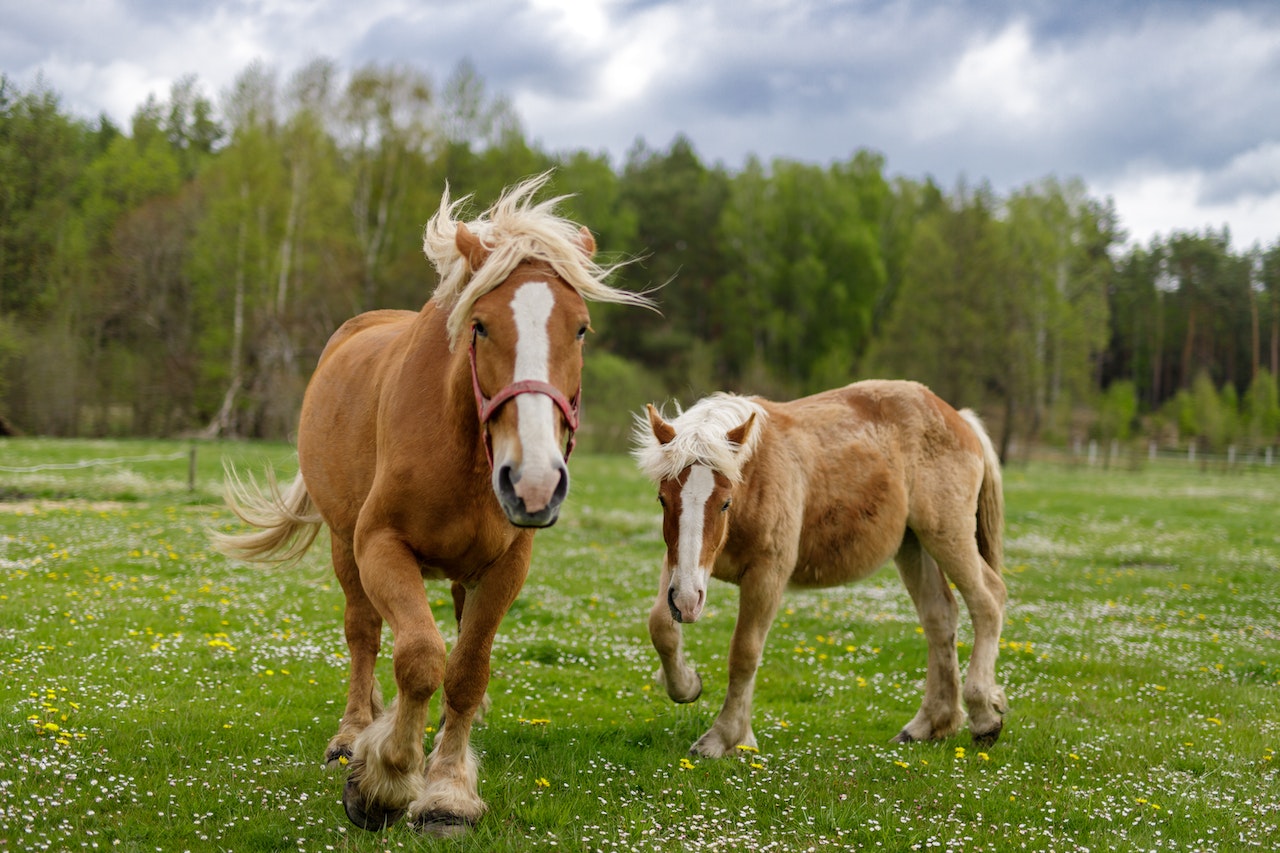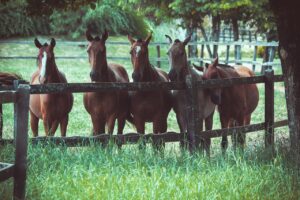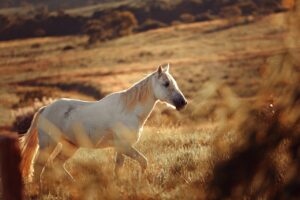FSB, Street No. 22, Punjab, Pakistan
The Symptoms & Treatment of the Seven Most Common Horse Illnesses:
In no particular order, strangles, equine herpesvirus, colic, heaves, laminitis, and equine influenza are the most prevalent horse ailments. Keep in mind that it is challenging to determine disease prevalence with certainty.
New horse owners frequently believe that all you need to ride is a saddle. However, there is a lot you need to learn about horses, and it’s important to be aware of the symptoms and treatments of common horse diseases.
Common Equine illnesses:
For the sake of their horses’ health, horse owners should be knowledgeable about prevalent horse ailments. Your horse could suffer fatal consequences if you don’t have a basic understanding of equine diseases and their causes.
This reduces your capacity to enjoy time spent riding your horses and hurts the animal as well. I’ll discuss the most prevalent equine illnesses, their origins, and symptoms, and I’ll give you tips on how to keep your horse healthy and free from these conditions. The same as with humans, some horses still get sick despite the best medical attention.
Strangles (Streptococcus equi)
A horse’s throat lymph nodes can become infected with strangles due to germs. Lymph nodes that are infected enlarge and rupture. Pus spills out of the horse’s snout and under its jaws when the infected nodes rupture. The name “strangles” comes from the sick horse’s swollen and burst lymph nodes.
The bacteria that causes the illness, Streptococcus Equi, is conveniently spread from horse to horse. The germs can exist for days in a barn and on the tack without being inside the animal’s body. Usually, it spreads through horse farms through shared water sources and equipment. One resilient bacteria that has been present for generations is Streptococcus equi.
Symptoms of Strangles:
A bacterial infection known as strangles causes the lymph nodes of infected horses to develop abscesses that enlarge and rupture, releasing a thick, yellowish-green mucous snot. Fever, mucous discharge, depression, lethargy, coughing, decreased appetite, and trouble swallowing are just a few of the signs of an infected horse. Strangles rarely results in death, but in rare instances, horses with the condition have passed away.
Prevention of strangles:
Due to its difficulty in treatment, strangles is one of the most prevalent horse diseases worldwide. Since the fourteenth century, the condition has existed. The disease has some vaccinations, however, the majority of them have unfavorable side effects, making their usage dubious. Thorough testing and isolating sick horses and equipment are the best ways to stop the disease. If the horse test results are positive, you should disinfect everything and isolate the afflicted animal.
Being thorough is necessary for effectiveness; keep in mind that this bacteria is resilient and may survive in harsh environments and temperatures. Clean up any equipment the horse contacted as well as all of your clothing. Maintaining good hygiene will aid in limiting the disease’s ability to spread to other farm animals.
In order to treat strangulation:
Using a scope and a topical antibiotic, the pus in the lymph glands may be removed as part of the treatment. Veterinarians frequently administer horses anti-inflammatory medicine to lower fever and have them feeling well enough to resume feeding before this is necessary.
Feeding moist food on the floor and applying hot compresses to the lymph glands both aid in the rupture and drainage of abscesses. On occasion, veterinarians will recommend an antibiotic regimen.
Equine herpesviruses:
The most prevalent equine virus and one of the most prevalent horse illnesses worldwide is equine herpesvirus-4. It frequently results in respiratory problems, and sporadically in abortion or neurological issues. Herpesvirus-1, which causes respiratory conditions, abortion, and neurological disorders, is another prevalent herpesvirus strain. Weanlings and yearlings are the animals most often affected by both strains.
Symptoms of equine herpesvirus infection:
Fever, coughing, nasal discharge, swollen lymph nodes, lethargy, weight loss, and eye infections such as conjunctivitis and keratitis are signs of the more prevalent equine herpesvirus-4.
Prevention of equine herpesvirus infection:
To stop the equine herpes virus from spreading:
Separate out sick horses.
Share no tools, and clean up all communal places.
After coming into contact with an infected horse, use hand sanitizer.
There are vaccines available for some herpesvirus strains, but they appear to do more to stop the disease from spreading than to shield a horse from getting it. I’m not aware of any immunizations that will shield a horse from all types of equine herpesvirus.
Equine herpesvirus infection treatment:
A nasal swap test can be used to determine whether your horse is infected with the equine herpes virus. But once it gets the condition, what therapeutic choices are available?
Medications are frequently used as part of treatment to lower fever and coughing, and an antibiotic cycle may also be prescribed to stop secondary infections. Otherwise, the respiratory condition must progress naturally.
If the condition progresses to neurological impairments, the horse may require a sling to keep it upright. In severe situations, intravenous infusion of meals and fluids is done.
Colic:
Gas, intestinal obstruction, eating too much grain, sand ingestion, and parasite infection are a few of the typical causes of colic. Check your horse’s vital signs, keep it upright, and call your veterinarian if you think it may be experiencing colic.
Wait until you’ve spoken to your vet before allowing your horse to eat or drink.
Consequences of equine colic:
Colic in horses causes diverse behavior. I’ve really witnessed this happen to a few horses; one of them flipped over, while another kicked at its stomach and tipped its head back.
It might be difficult to determine whether your horse has colic because they exhibit so many varied behaviors when they are ill. The following is a list of the colic symptoms that horses most frequently exhibit:
- reduced appetite
- ground with one’s paws
- Backing up to its flank
- laying down Excessive frantic movement, such as bouncing up and down constantly or circling in place.
- Lips upper lip curled
- At its gut, kicking
- swaying on the floor
- Stretching
- Sweating
- higher heart rate
- enlarged abdomen
- very little to no manure
- Diarrhea
preventing colic in horses:
Colic is not always preventable, unlike some of the other frequent horse ailments, but there are things you can do to reduce your horse’s risk of getting the illness.
Have a water supply that is easily accessible for your horse,
Turn out your horse as much as you can.
Hay should not be fed on the sand.
If your horse doesn’t require the extra energy, don’t feed it grain.
Gradually alter your horse’s food.
Maintain floated teeth for your horse.
Have a successful pest control strategy.
Equine colic treatment:
Colic is a broad phrase, thus it’s important to identify the reason and administer the appropriate care. The majority of colic conditions can be managed medically, but severe cases, like impactions and intestinal twists, necessitate surgery.
As quickly as possible, you must have your horse examined by a veterinarian so that he can decide on the best course of action. When treating colic, the veterinarian will frequently give medication or utilize a tube to alleviate gas on site.
Heaves:
Heave is an equine form of chronic lung disease, comparable to human asthma, but unlike many other common equine illnesses, it is not contagious.
Recurrent airway obstruction (RAO), chronic obstructive pulmonary disease (COPD), broken wind, and emphysema are some of the various names for the ailment.
Heaves are an allergic reaction in horses to airborne particles, usually molds found in hay and straw. The airways in the lungs narrow due to an allergic reaction brought on by the inhaled particles. Horses older than six years are more susceptible to heaves.
Once the airways are blocked, the horse finds it difficult to get air into and out of its lungs, which restricts its capacity to carry out simple duties.
Symptoms of heaves:
Early symptoms of heaves include infrequent coughing, but as the condition progresses, the horse will get quickly exhausted during exercise and have a higher respiratory rate. Along with starting to wheeze, the animal will also start to flare its nostrils and produce nasal discharge.
A horse with heaves will appear swollen if the illness is allowed to worsen without treatment. The growth of big stomach muscles as a result of regular overuse in order to draw in the air is what gives the appearance of being bloated.
Prevention of heaves:
Dust should be avoided by horses who tend to heave. Give your animal as much time on the pasture as you can, and steer clear of feeding hay. Yes, hay is necessary for horses, but there are alternatives like hay pellets and cubes.
If you must feed hay, remove dust before feeding it to your horse by soaking or steaming it. Additionally, if your horse is kept in a stall, make sure it is as dust-free and well-ventilated as you can.
Treatment for heaves:
Please call your veterinarian right away if you think your horse is growing. He can lessen the symptoms and stop the disease from worsening even if there is no cure.
Depending on what’s causing your horse’s heaves, the doctor can advise taking an anti-inflammatory drug regimen. Veterinarians typically provide the medications intravenously or orally.
Similar to human inhalers, there is also an aerosol option for horses. These have shown to be affected, however, treatments are expensive and call for specialized equipment.
Horses with heaves frequently make a full recovery and lead productive lives when their condition is properly handled, particularly with better air quality.
Laminitis:
One of the most prevalent conditions affecting a horse’s hoof is laminitis. The tissues connecting the hoof wall to the coffin bone, commonly known as the pedal bone, are affected by this agonizing and frequently reoccurring ailment.
Blood flow to the laminae, which anchors the coffin bone to the hoof wall, is disturbed, which leads to the disease. Inflammation brought on by the condition impairs the laminae and their connection to the hoof wall.
The coffin bone may rotate inside the horse’s foot when the connection is broken, sink, and then come out of the bottom of the hoof. Front feet are most frequently affected by laminitis. The terms “founder” and “laminitis” are interchangeable to describe the ailment.
Symptoms of laminitis:
Lameness is a gradual condition brought on by laminitis. Knowing the early warning symptoms is crucial for catching the illness before it has a chance to recover. Get in touch with your veterinarian straight once if you think your horse may be suffering from laminitis.
Following is a list of typical early symptoms of laminitis:
feet with a higher digital pulse. To examine the digital pulse in horses with laminitis, slide your fingers under the fetlock just above the hoof; the heartbeat is loud and thumping. To establish a benchmark, compare it to a healthy horse.
the temperature in the horses’ feet. The animal’s foot becomes heated when it is injured. It may be an early indicator of laminitis if your horse’s hoof is consistently hotter than normal for more than two hours.
strange rings on the hoof wall. Laminitis may be present if you notice that the hoof rings are getting broader from the toe to the heel.
increased heart rate during rest. Your horses should have a baseline heart rate; if you detect an increase over an extended period of time, this may be a sign of laminitis.
frequently shifting weight. Horses with early laminitis symptoms will frequently shift their weight from side to side.
Blood or a widening of the white line. The white line is located where the sole and hoof wall converge. It might be caused by laminitis if you notice that it is broader than usual or that there is blood in the area.
Adapting to change. Laminitis may be to blame if your horse starts to stride differently, usually taking shorter strides.
The toe of the hoof is hurting. Use hoof testers to apply pressure to the toe of the hoof; if your horse reacts negatively, laminitis may be the culprit.
Back on its heels: Laminitic horses frequently lean back on their heels to relieve pressure on the front of their feet because laminitis causes pain in the toe of the hoof.
Prevention of laminitis:
In some situations, a healthy diet and exercise routine can help avoid laminitis. The majority of horses should simply eat pasture. Sugars and grains cause laminitis. Sugar levels in lush pasture grass are high, and horses who are prone to laminitis should stay away from it.
Maintain a healthy weight range for your horse. Equine obesity increases the risk of laminitis. Never overfeed a horse, and always make diet adjustments gradually.
Since horses’ digestive systems are delicate, abrupt dietary changes will upset their equilibrium and cause laminitis. Taking good care of your horse’s hooves is crucial for preventing laminitis. Incorrectly balanced feet impose undue strain on the hooves and can cause laminitis.
Laminitis treatment:
Emergency care is required in situations of severe laminitis, but even in mild cases, the sooner recovery begins, the better. Depending on the particulars pertaining to each horse, the method of treatment often consists of:
Medication: In order to manage the pain, painkillers, and anti-inflammatory medications are given. Phenylbutazone is a frequently prescribed anti-inflammatory medication. Acepromazine is frequently used to improve blood circulation to the feet.
Ice: Applying ice to feet with laminitis linked with inflammation can help to reduce swelling and keep the feet cool.
Dietary restrictions: covered in the preventative section above.
Mineral oil: Providing a dose of mineral oil to horses who have overate after entering a feed room is helpful.
Lessen your foot pressure. On a soft surface, keep your horse. Pain and stress are exacerbated by concrete and other hard surfaces. The horse should ideally lie down to relieve all foot pressure. Affected feet can experience less stress with the aid of corrective footwear.
Remove abscesses: Pressure builds as abscesses form inside the horse’s foot. Inflammation is exacerbated and made painful by the pressure in the hoof.
Influenza in horses:
Equine influenza consistently ranks near the top of the list of prevalent horse diseases each year. Equine influenza is extremely contagious. Although there are two main virus strains that can cause illness, equine influenza A (H3N8), which affects the horse’s respiratory system, is the more prevalent.
When a horse coughs, equine influenza is spread through the air. When you go to horse shows, go on trail rides, or go anywhere horses congregate, your horse could catch it.
Australia set the bar for how quickly this disease spreads over the world. There were no reported horse flu cases prior to 2007. Then, in early August of that year, eight diseased horses were brought, and within six weeks, 1000 horses had the illness, which kept spreading.
Equine influenza symptoms:
Lethargy, loss of appetite, fever, nasal discharge, coughing, and swollen lymph nodes are typical signs of horse influenza.
Equine influenza prevention:
The best defense is to avoid strange horses, particularly those who have a cough. Additionally, maintain appropriate hygiene and refrain from sharing water sources or grooming supplies with horses from other stables.
Make quick contact with your veterinarian if you think one of your horses may be suffering from the equine flu so he can test it. Keep your horse isolated from your other animals if it tests positive for the flu.
Equine influenza virus vaccinations come in two varieties: modified-live vaccines for intranasal delivery and inactivated (killed) vaccines for intramuscular administration.
Equine influenza vaccinations can lower your horse’s risk of contracting the illness, but they cannot guarantee it.
For equine influenza treatment:
Your veterinarian will probably advise you to give supportive care and that the flu must run its course. Your horse will probably need to be kept in a tidy, well-ventilated stall or paddock, and you’ll need to make sure it has access to clean water and enough hay.
Banamine may be prescribed by your veterinarian to lower the animal’s temperature. There isn’t much you can do but wait for the sickness to run its course, aside from treating subsequent ailments.
EIA is anemia contagious in horses:
Even though equine infectious anemia is not one of the most prevalent horse diseases, it spreads quickly and wreaks such havoc that I felt it was wise to mention it in this post.
Horse and deer flies are the main vectors of the viral disease known as equine infectious anemia (EIA), which is conveyed in the blood. An animal with EIA will not exhibit indications of the illness right away.
Lentiviruses are illnesses that have an incubation period after infection before the disease starts to cause symptoms of illness. Because an infected horse will appear healthy yet still be able to spread the disease to other horses nearby, lentiviruses are particularly deadly.
Equine infectious anemia in horses may not manifest any symptoms for up to 45 days or as early as 7 days. A horse will always be infected with EIA once they have the condition.
Equine infectious anemia symptoms:
High fever, despondency, swelling in the lower legs, and persistent weight loss are common recurrent symptoms in horses with equine infectious anemia. You might also notice that their eyes have turned yellow.
Horses with acute EIA are frequently fatal within a couple of weeks; they commonly have a surge in fever. Those who do survive frequently have the illness for the rest of their life.
Chronic EIA-afflicted horses experience a cycle of ongoing illness. They have fluid retention, a fever, and weight loss.
Some horses carry the disease yet show no outward symptoms. Other animals may catch it from them. For all horses, a Coggins test is essential because of this.
Prevention of infectious anemia in horses:
Have your horse tested annually, quarantine affected horses, implement a successful bug control strategy, and only participate in open events where Coggins testing is necessary to lower your chance of contracting EIA. These actions lower the possibility of EIA in horses.
EIA in the US has considerably decreased as a result of horse testing. Equine infectious anemia was common prior to the 1970 introduction of the Coggins test.
Even though testing has significantly reduced the condition, some horses continue to test positive for it each year.
Horses with EIA receiving treatment:
For horses who get this illness, there aren’t many options, sadly. Your horse has two options: you can keep it separate from other animals, or you can put it to death.
Conclusion:
Although not a comprehensive list, these are prevalent horse ailments that all owners should be aware of. You should also be aware of a great deal more conditions and illnesses, such as equine sleeping disease, joint disorders, and thrush.
You must immediately consult a veterinarian if you have any worries about your horse’s health. Keep in mind that all horse owners are always learning more about their animals.
Proper Nutrition for High-Performance Horses




